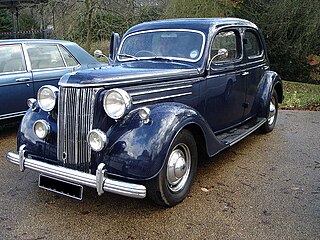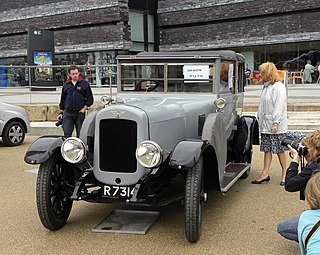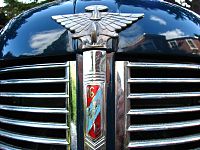
The Citroën DS is a front mid-engined, front-wheel drive executive car manufactured and marketed by Citroën from 1955 to 1975, in fastback/sedan, wagon/estate, and convertible body configurations, across three series of one generation.

The Austin Motor Company Limited was a British manufacturer of motor vehicles, founded in 1905 by Herbert Austin in Longbridge. In 1952 it was merged with Morris Motors Limited in the new holding company British Motor Corporation (BMC) Limited, keeping its separate identity. The marque Austin was used until 1987 by BMC's successors British Leyland and Rover Group. The trademark is currently owned by the Chinese firm SAIC Motor, after being transferred from bankrupt subsidiary Nanjing Automotive which had acquired it with MG Rover Group in July 2005.
Armstrong Siddeley was a British engineering group that operated during the first half of the 20th century. It was formed in 1919 and is best known for the production of luxury vehicles and aircraft engines.
The Chevrolet Stovebolt engine is a straight-six engine made in two versions between 1929 and 1962 by the Chevrolet Division of General Motors. It replaced the company's 171-cubic-inch (2.8 L) inline-four as their sole engine offering from 1929 through 1954, and was the company's base engine starting in 1955 when it added the small block V8 to the lineup. It was completely phased out in North America by 1962, but GM continued to build it in Brazil until 1979. It was replaced by the Chevrolet Turbo-Thrift engine.

The Ford Pilot is a medium-sized car that was built by Ford UK from August 1947 to 1951. It was effectively replaced in 1951 with the launch of Ford UK's Zephyr Six and Consul models, though V8 Pilots were still offered for sale, being gradually withdrawn during that year. In its production run 22,155 cars were made.

Singer Motors Limited was a British motor vehicle manufacturing business, originally a bicycle manufacturer founded as Singer & Co by George Singer, in 1874 in Coventry, England. Singer & Co's bicycle manufacture continued. From 1901 George Singer's Singer Motor Co made cars and commercial vehicles.
The Lanchester Motor Company Limited was a British car manufacturer in active trade between 1899 and 1955. Though the Lanchester Motor Company Limited is still registered as an active company and accounts are filed each year, the marque has been dormant since. As of 2014 it is marked as "non-trading".

The Austin A90 Atlantic is a British car produced by the Austin Motor Company from 1949 until 1952. It was launched initially as a four-seat convertible, making its début at the 1948 Earls Court Motor Show in London, with production models built between early 1949 and late 1950. A two-door coupé, marketed as the A90 Atlantic sports saloon, followed a year later. It had been previewed at the 1949 Motor Show and was in production at Longbridge between 1950 and 1952.

The Riley RM is a series of executive cars and compact executive cars that were made by Riley Motors from 1945 until 1955. They were the last models developed independently by Riley before its parent company, Nuffield, merged with Austin to form BMC. The RM series was produced in Coventry until 1949, when production moved to the MG works at Abingdon. Until 1952, models were marketed as the Riley 1½ Litre and the Riley 2½ Litre. the term RM has been used retrospectively to encompass models produced before 1952.

The Austin Cambridge is a medium-sized motor car range produced by the Austin Motor Company, in several generations, from September 1954 through to 1971 as cars and to 1973 as light commercials. It replaced the A40 Somerset and was entirely new, with modern unibody construction. The range had two basic body styles with the A40, A50, and early A55 using a traditional rounded shape and later A55 Mark IIs and A60s using Pininfarina styling.

The Austin A70 Hampshire and later Austin A70 Hereford are cars that were produced by Austin of Britain from 1948 until 1954. They were conventional body-on-frame cars with similar styling to the smaller A40 Devon and A40 Somerset models respectively, though with an entirely different larger and wider body on chassis construction. 85,682 were built.

Wolseley Motors Limited was a British motor vehicle manufacturer founded in early 1901 by the Vickers Armaments in conjunction with Herbert Austin. It initially made a full range, topped by large luxury cars, and dominated the market in the Edwardian era. The Vickers brothers died and, without their guidance, Wolseley expanded rapidly after the war, manufacturing 12,000 cars in 1921, and remained the biggest motor manufacturer in Britain.

The Wolseley 15/60 is an automobile which was produced from 1958 to 1961, and then, as the Wolseley 16/60, from 1961 to 1971. The 15/60 was the first of the mid-sized Pinin Farina-styled automobiles manufactured by the British Motor Corporation (BMC). Launched in December 1958 as part of BMC's Wolseley brand, the design would eventually be shared with seven other marques. All of the cars were updated in 1961 with a larger engine and new model designations. The Wolseley 16/60 was the last, in production until 24 April 1971.

The Austin 7 is an economy car that was produced from 1922 until 1939 in the United Kingdom by Austin. It was nicknamed the "Baby Austin" and was at that time one of the most popular cars produced for the British market and sold well abroad. Its effect on the British market was similar to that of the Model T Ford in the US, replacing most other British economy cars and cyclecars of the early 1920s. It was also licensed and copied by companies all over the world. The first BMW car, the BMW Dixi, was a licensed Austin 7. In France they were made and sold as Rosengarts, and in the United States they were built by the American Austin Car Company. In Japan, Nissan also used the 7 design as the basis for their first cars, although not under licence. This eventually led to a 1952 agreement for Nissan to build and sell Austins in Japan under the Austin name.

The Rolls-Royce Wraith was built by Rolls-Royce at their Derby factory from 1938 to 1939 and supplied to independent coachbuilders as a rolling chassis.

The Armstrong Siddeley Lancaster is an automobile which was produced by Armstrong Siddeley Motors Limited from 1945 until 1952. It was the first post-war sports saloon to be made by the company.

The Armstrong Siddeley Typhoon is a two-door, four-seat fixed-head coupé automobile produced by the British company Armstrong Siddeley from 1946 until 1949. It was based on the Armstrong Siddeley Lancaster saloon and continued the company's theme of naming cars after Hawker Siddeley World War II aircraft.

Austin Twenty is a large car introduced by Austin after the end of the First World War in April 1919, and continued in production until 1930. After the Austin 20/6 model was introduced in 1927, the first model was referred to as the Austin 20/4.

The Austin 15 hp is a 2.8-litre motor car manufactured by the British manufacturer Austin and first displayed at the seventh exhibition of motor vehicles which opened at London's Olympia in November 1908. Its tax rating was 20 horsepower. It was sold between 1908 and 1915.


















